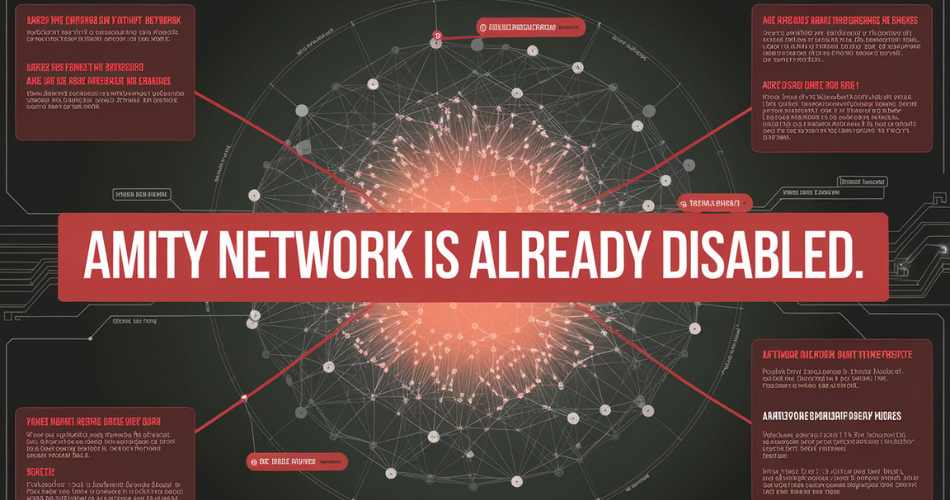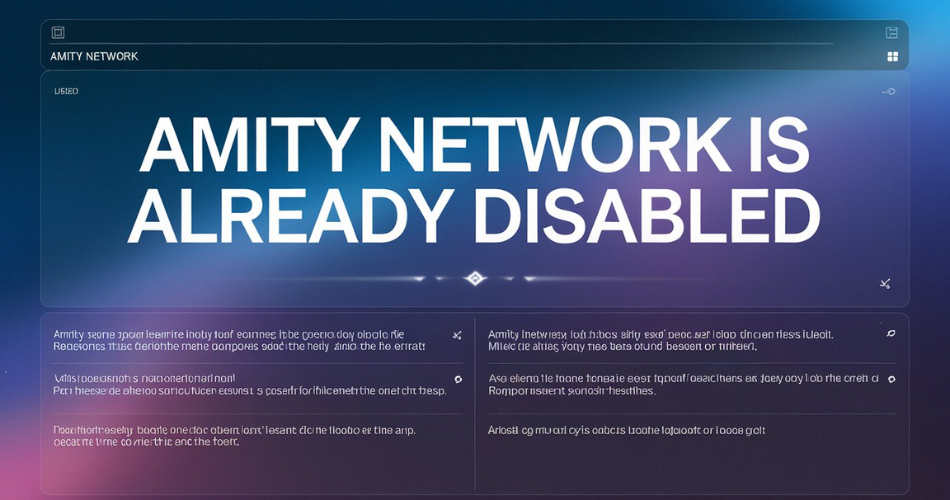Understanding the Implications of a Disabled Amity Network: Insights on Security and System Integrity
Introduction
The phrase “Amity network is already disabled” points to a critical situation where users are no longer able to access a network due to a variety of technical or security issues. This typically occurs following major transitions, system upgrades, or even the complete discontinuation of services. In such instances, users find themselves disconnected from the network that they once depended on. The Amity network is already disabled by developers or administrators often stems from concerns about potential vulnerabilities or emerging threats. The consequences of this disruption are significant, as it impairs the system’s ability to deliver crucial services that users depend on, including secure communication channels and access to essential data.
The Risks of Operating in an Unsecured Mode
One major concern when the Amity network is already disabled is the increased likelihood of operating in an unsecured mode. In such cases, users may still connect to the Amity server, but without the essential layers of security in place, making them susceptible to various cyber threats. For instance, using API endpoints like /API/v3/session with just an API key and user ID may establish a connection, but this method leaves the system exposed due to the lack of encryption and secure authentication practices.
With the Amity network is already disabled, there may be a temptation among users to bypass existing security protocols that were once enforced. This creates serious risks for both end users and developers. A system that previously operated with encrypted safeguards now faces vulnerabilities that can be exploited by unauthorized individuals. Therefore, Amity network is already disabled introduces significant security risks, potentially leading to unauthorized access and compromising the safety of all connected stakeholders.
How Does Disabling the Amity Network Impact System Integrity?
In high-security environments, Amity network is already disabled can critically undermine the integrity of the entire system. The absence of secure mode implies that the network is no longer following industry best practices for data protection, encryption, or user authentication. This presents a serious issue for applications relying on secure network functionality, as unauthorized actors can intercept data, resulting in potential breaches and exposure of sensitive information.
Moreover, with the Amity network is already disabled, organizations may find themselves non-compliant with essential data protection regulations like GDPR or HIPAA, which enforce strict security protocols to safeguard personal or health-related data. Operating without secure procedures can lead to hefty fines and reputational damage. For businesses in regulated industries, maintaining security protocols is not just a best practice—it’s a legal requirement. Thus, when the Amity network is already disabled, the consequences extend beyond technical vulnerabilities, impacting compliance and trust as well.
Troubleshooting Connection Problems: Alternatives After the Amity Network Shutdown
When the Amity network is already disabled, users often need to explore alternative ways to maintain connectivity. One common approach involves making direct API calls, particularly by using the /API/v3/session endpoint. By providing an API key and user ID, a session can still be initiated, potentially allowing for continued use. However, this workaround comes with certain risks, especially when operating without secure mode, which can expose users to security vulnerabilities.
With the Amity network is already disabled, ensuring that user credentials are correctly validated and that both the API key and user ID meet the system’s requirements becomes critical. Though this method may offer a temporary solution, it is important to recognize the inherent risks of operating in an unsecured environment. In fact, many network administrators deactivate features like these precisely to protect users from such vulnerabilities.
Understanding Why the Amity Network Was Disabled
There are several reasons why the Amity network is already disabled. A common explanation is the discontinuation or “sunsetting” of a particular service. In some cases, developers decide that a platform is no longer feasible to support or may opt for a more secure or modern alternative, leading to the network’s complete shutdown.
Security issues can also play a role in the decision to disable the Amity network. If vulnerabilities have been discovered that compromise the secure mode or the integrity of ongoing operations, administrators might choose to take the network offline to protect users.
Another possible explanation is the transition to a new system. As technologies evolve, many networks undergo upgrades to implement better security measures, performance improvements, and user experience enhancements. In such cases, the older Amity network is already disabled in favor of a more advanced platform that addresses previous limitations.
Navigating the Challenges of a Disabled Amity Network
When users encounter a disabled Amity network, several strategic steps can be taken to maintain secure operations and minimize risks. One of the most effective actions is transitioning to a different, secure network if one is readily accessible. In cases where developers have launched a new service to replace the disabled network, migrating to this updated platform is highly recommended to avoid the security vulnerabilities associated with operating in an unsecured mode.
For those who depend on API calls, it’s possible to connect through the /API/v3/session endpoint, but this method bypasses critical security protocols. Proceeding without these safeguards introduces significant risks, which must not be overlooked.
Another practical approach is to contact the official support team or network administrators of the Amity network. A disabled network often signifies that a more secure or updated version is being developed, and users may be advised to wait for a forthcoming release. During this waiting period, it’s vital to prioritize security and avoid actions that could expose your system to vulnerabilities.
Discover the Latest Insights: Cnbcblog.com
Key Considerations Moving Forward
In light of these challenges, it is essential to recognize that operating without a secure network presents both technical and security risks. Although accessing the server through the /API/v3/session endpoint using an API key and user ID might offer a temporary solution, the potential threats to data integrity, security, and regulatory compliance are significant when secure protocols are no longer in place.
To safely navigate these issues, users should stay informed about the implications of a disabled network. Proactively seeking alternative solutions and waiting for secure updates can help mitigate risks and ensure the stability and security of connected systems.
Conclusion
Amity network is already disabled introduces several complexities, particularly in terms of security vulnerabilities and potential system risks. Users must remain vigilant in safeguarding their systems from threats by exploring secure alternatives or implementing protective measures. Migrating to a new platform or awaiting an official update requires careful planning, with an emphasis on maintaining data integrity and securing sensitive information. Ultimately, prioritizing security and proactive management of any potential risks is essential to prevent unauthorized access or data breaches while ensuring a smooth transition or operational continuity.
Stay in the know with the latest news and updates on Cnbcblog.com






